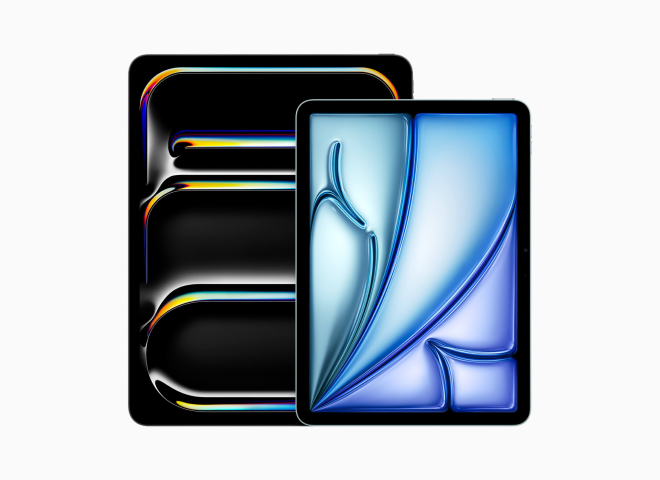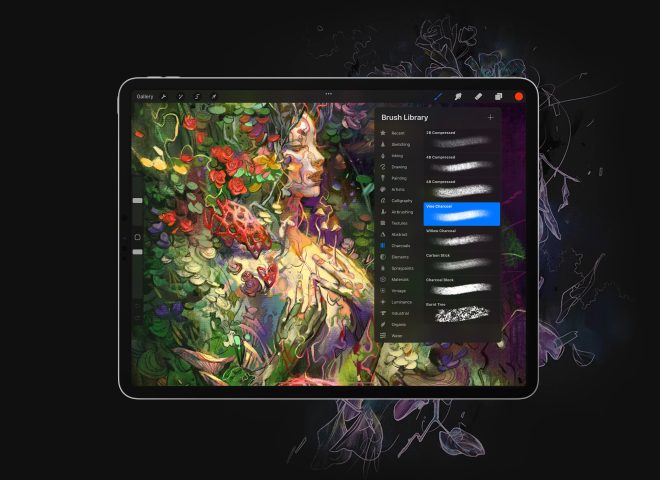In the world of digital notetaking apps, two names reign supreme. Goodnotes vs. Notability has been a long-standing debate, and we want to get to the bottom of it.
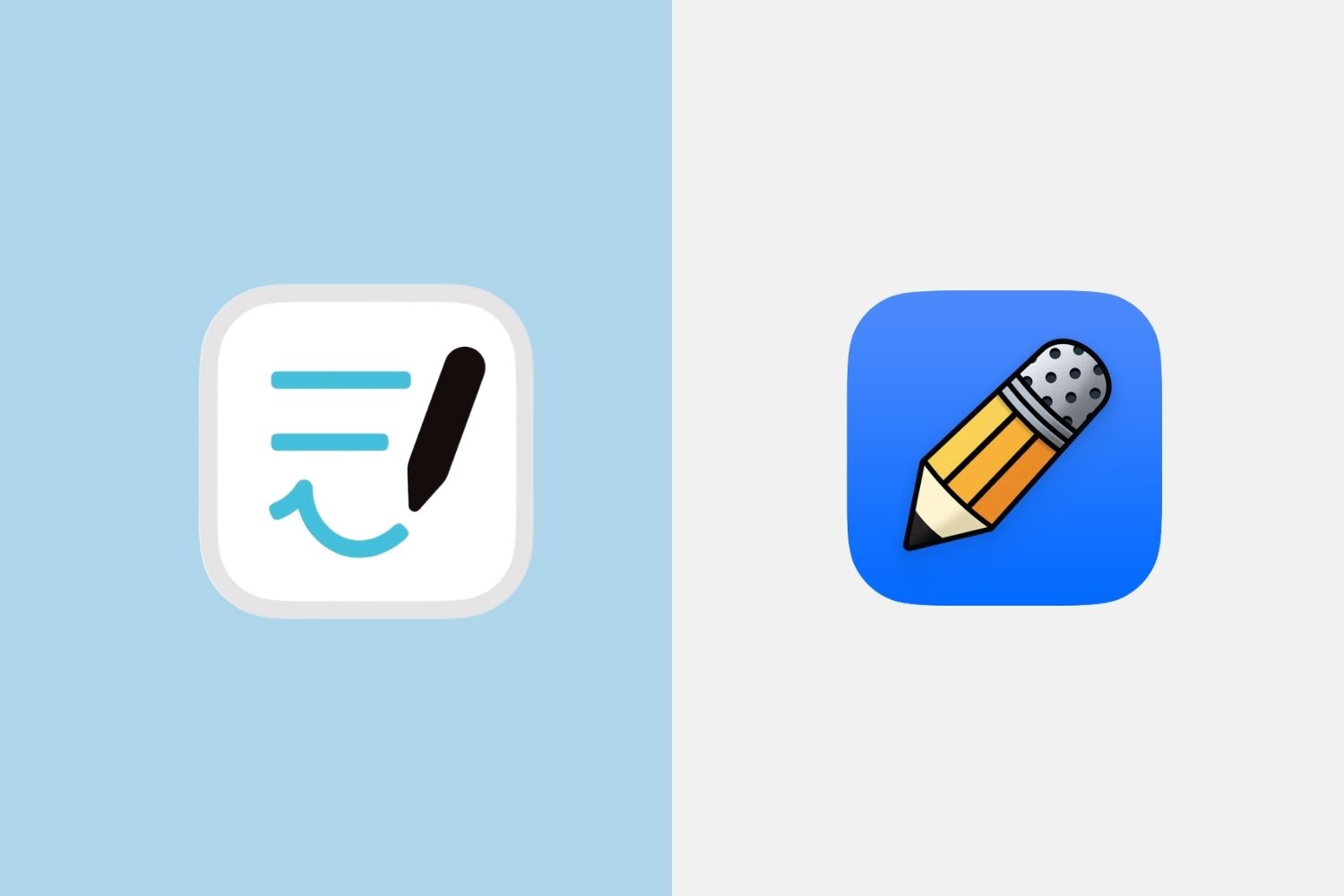
Goodnotes vs. Notability: The Basics
Goodnotes is a self-proclaimed AI notetaking app that is “loved by millions around the world.” Time Base Technology launched this app in 2011 to give notetakers an alternative to traditional pen and paper. Now, it’s known for using a pioneering generative AI to improve digital notetaking.
Like its competitor, Notability is not shy about its success. It claims to be the “best-selling paid notetaking app on the App Store.” Ginger Labs launched one year before Goodnotes and marketed itself mainly to students.
Let’s take a look at a few more specific comparisons of Notability vs. Goodnotes.
Goodnotes vs. Notability: Features at a Glance
Goodnotes – Features
- AI writing support – AI automatically checks spelling and gives word prompts.
- AI-guided study sessions – AI Math Assistant guides interactive SAT exam-prep materials.
- Handwriting-to-text conversions – Handwritten text is automatically converted into typed notes.
- Flashcards – Transforms notes into flashcard-based study sets that are powered by a spaced repetition algorithm.
- Edit and annotate PDFs – Allows you to sign, highlight, and annotate PDFs with ease.
- Audio record – Records audio clips that are synced with either typed or handwritten notes.

Notability – Features
- Audio transcription – Time-stamped transcripts of your audio recordings that can be synced with handwritten or typed notes.
- Handwriting-to-text conversions – The “Scribble” feature allows you to transform handwritten notes to text, with a few extra steps.
- Math conversion – Handwritten mathematical expressions are transformed into text formulas or typed notes.
- Multi-note – Work on two notes at the same time with either a horizontal or vertical view.
- Reminders with Siri – Set up reminders for notes with Siri.
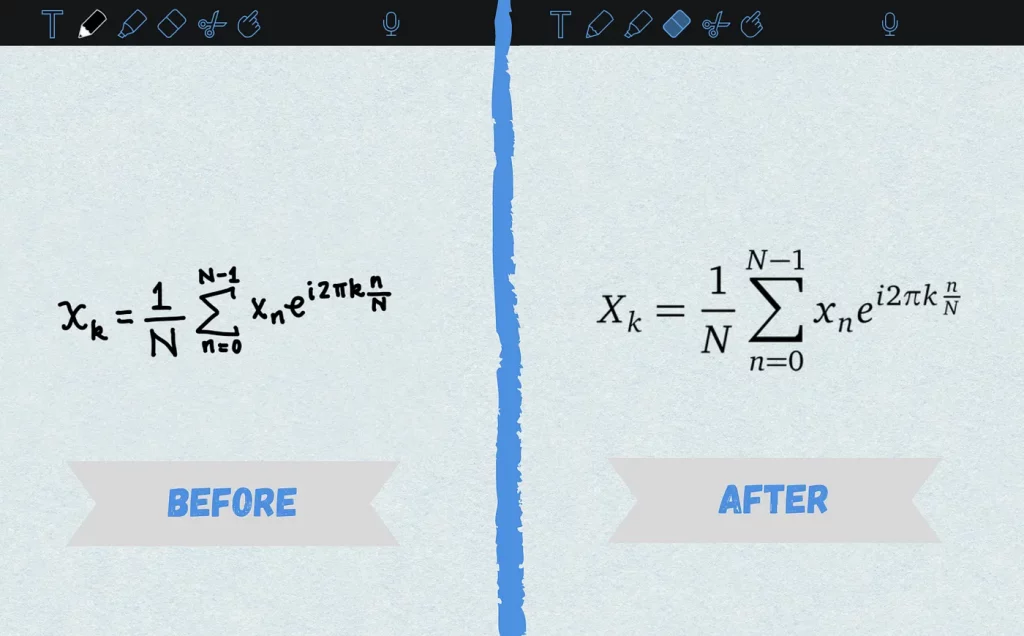
Goodnotes vs. Notability: Updates
A note-taking app is only as good as the dev team behind it. Before you rush into choosing either Goodnotes or Notability, you should pay close attention to the updates.
Goodnotes – Updates
On August 9th, 2023, Goodnotes 5 users were automatically transitioned to Goodnotes 6. Rather than getting an update, users got a new version of the app.
There are lots of new features, including a brand new user interface that includes generative AI for handwritten notes and automatic spelling detection and correction in your unique handwriting style.
Here are some of the other interesting features.
- Colored folders with custom icons
- New pen gestures including circle to select and scribble to erase
- Math conversion with LaTeX support
- Interactive exam practice with AI Math Assistance
The last feature, which requires a bit more context, is called The Marketplace. It is a platform for third-party content creators to sell unique planners, paper templates, covers, sticker packs, and more. Once users purchase a product, it will be automatically added to their Documents View, Elements Collection, or Template Library.
As impressive as this update sounds, it has not been well-received across the board. One of the biggest question marks is why the Goodnotes team has changed Goodnotes 5 to Goodnotes 6 on the App Store. This move might initially make sense, but it also means that all the positive reviews from Goodnotes 5 are automatically attributed to Goodnotes 6.
Pros
- Generative AI allows you to fix spelling mistakes without rewriting notes.
- Even more customization options for folders, ideal for committed notetakers.
- The Marketplace is a new form of income for creatives.
- Interactive exam practice allows you to bounce ideas off an intelligent AI.
Cons
- The AI autocorrect and word completion features are not always accurate.
- Goodnotes converts maths formulas to vector images, which eliminates the possibility of correcting errors.
- Some fans question the ethics of replacing Goodnotes 5 with Goodnotes 6 on the App Store.
Notability – Updates
Just like Goodnotes, Notability has plenty of cool new features.
One of the most prominent updates is the user interface overhaul. Now, users can view notes in full screen (with just the title of the note at the top of the page) meaning there is more space for creativity. Recents, Favorites, Unfiled, and Shared Notes are also grouped together to clean up the sidebar.
The new Notability Widgets feature streamlines your note-taking process. You can choose from four functions (create a new note, access a specific note, view a specific subject’s list of notes, and view your Recent Notes subject) and add a widget to your home page.
Of course, some users are unhappy that the dev team has chosen to focus on these issues rather than other ongoing problems. Users report that typing in text boxes causes freezing or crashes and that copying and pasting external images does not work.
Pros
- Widgets act as effective shortcuts that allow you to pick up where you left off.
- The full-screen feature creates more real estate for note-taking.
Cons
- The overall more minimalist, clean appearance can be frustrating for some as it requires extra work to reach essential tools.
- Some fans say the app does not recognize their subscription.
Winner: Goodnotes
When we talk about Goodnotes vs. Notability, we often think about the existing features. But what about the updates? If you are an avid, long-term notetaker, you need to find an app that reacts to your wants, needs, and even demands.
Goodnotes might not be perfect, but the new update shows that the dev team takes pride in listening to users and making massive innovations. Besides, no other note-taking apps can rival Goodnotes’ new AI-inclusive update.
Handwriting Conversion
Modern notetakers expect apps to have built-in handwriting conversion abilities, so it is no surprise that Goodnotes and Notability are so popular.
Goodnotes – Handwriting
Converting your handwriting to text in Goodnotes is simple and can be completed quickly using their lasso tool. Goodnotes also has a pretty impressive generative AI tool that acts as a writing aid. It generates text, spell checks, and corrects errors in your own handwriting style! The newest update (Goodnotes 6) can even suggest words. If you don’t want spellcheck or suggestions, you can press the pen icon and turn them off.
Pros
- Handwritten note to typed text conversion comes as standard in the free version of the app.
- To convert handwritten text to typed text, just preview the conversion and tap the “Convert” button.
Cons
- AI system does not notice spelling errors as quickly as we would like.
- AI writing aid is only available on iOS.
- Handwriting-to-text conversion is only available in 13 languages.
Notability – Handwriting
Notability also has an impressive handwriting-to-text feature. Just turn “Scribble” on and enjoy automatic transformations. This feature is available in 23 languages, which makes the app far more accessible than Goodnotes. That being said, the handwriting-to-text feature requires a few user inputs, which makes it feel clunky.
Pros
- Notability can change handwritten math equations into typed text.
- This app supports handwriting-to-text conversion in 23 languages.
Cons
- Handwriting-to-text conversions are only available on the Plus package.
- To convert handwritten text to typed text, users have to copy the converted text and paste it onto the page.
Handwriting Winner: Goodnotes
Both apps offer handwriting-to-text conversions, but Notability supports many more languages. On the flip side, Goodnotes supports fewer languages, but the introduction of a super-advanced generative AI writing aid makes it stand out from the crowd.
Goodnotes could definitely improve its offering by supporting more languages and broadening its compatibility, but the AI writing aid is impressive enough to win this round.
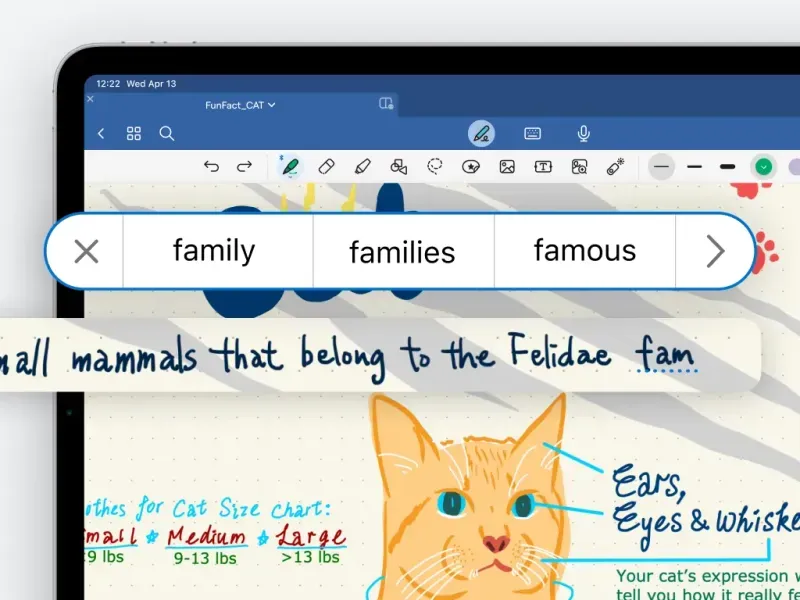
User Interface – Layout
Both Goodnotes and Notability are known for having intuitive, user-friendly interfaces. There are a lot of similarities between the home pages, so the small differences are glaringly obvious.
Goodnotes – Layout
When you open Goodnotes, you will see a clean, minimalist screen that prioritizes organization. You can choose to display your documents in either a list or grid format, and you can open the sidebar by pressing the Goodnotes icon on the uppermost left side of the screen.
Pros
- Users can tap on the name of any document to browse through more menu options.
- The sidebar gives you quick access to bookmarked note pages.
Cons
- Documents are arranged in alphabetical and numerical order, and can’t be manually rearranged.
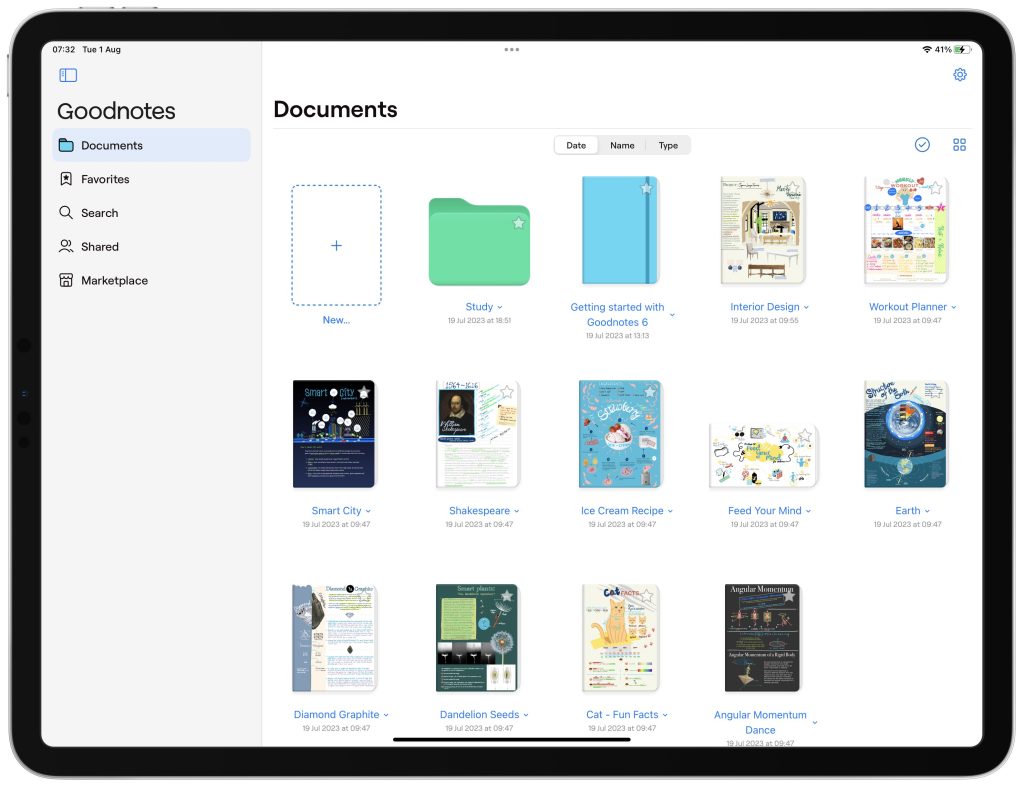
Notability – Layout
When you open Notability, you will see a list of folders on the left-hand side. Click on a folder, and the notes inside the folder will appear on the right. You can choose to view the notes in a grid or list format. On top of that, you can use collapsible toggles to divide your folders into sections.
Pros
- Grid view gives you a preview of each note, which is ideal for people who want to quickly scan their documents.
Cons
- The folder/notes/toggle system can feel confusing at first.
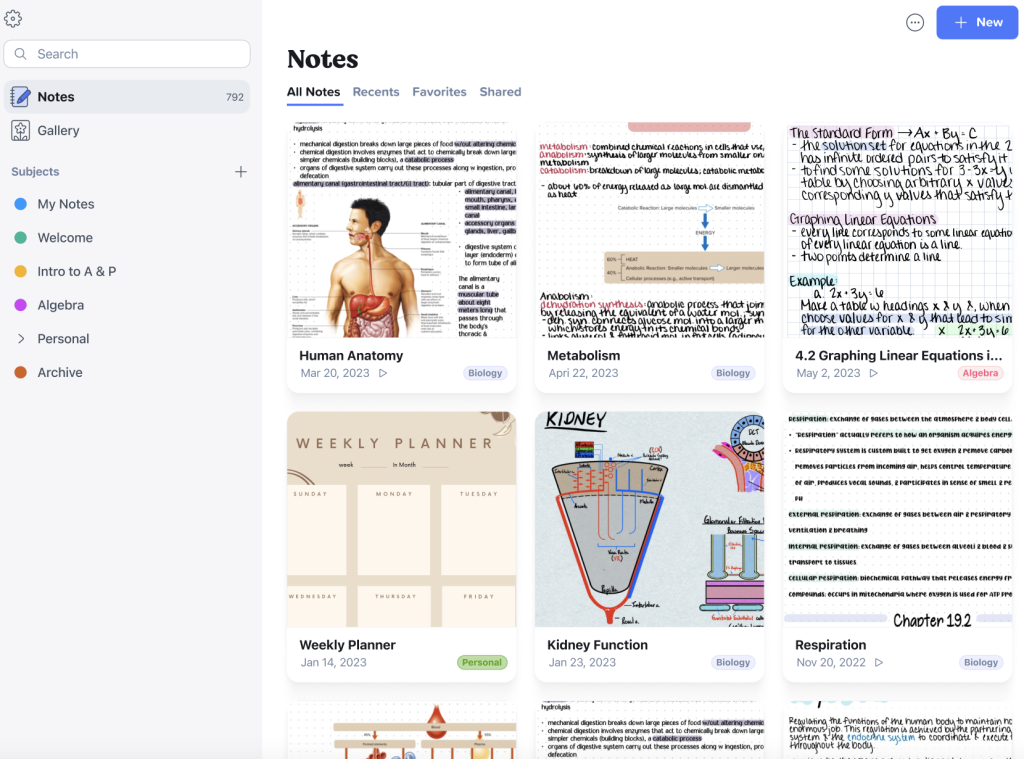
Layout Winner: Notability
In keeping with the minimalistic style of notetaking apps, both Goodnotes and Notability have relatively clean user interfaces. Choosing a winner in the battle of Notability vs. Goodnotes was difficult, but Notability is our winner.
The fact that Notability allows users to see inside their notes from the home screen is a huge bonus, especially for people who need visual cues. Goodnotes might have cinched the win if it didn’t have the frustrating alphabetical order system.
User Interface – Navigation
Navigation tells us how easy it is to move around an app and, most importantly, how easy it is to find what you are looking for.
Goodnotes – Navigation
True to the overall feel of the app, Goodnotes has super simple navigation. You can sort notes by “Name”, “Date”, “Type”, “All notes”, “Recents”, “Favorites”, “Unified”, and “Shared”. Even better, you can use the search bar to find a specific note within a matter of seconds, even if it’s handwritten!
Pros
- When you search for a word or phrase, Goodnotes will spot it in handwritten and typed notes.
- There are lots of sorting options, making navigation straightforward.
Cons
- Goodnotes’ search tool is pretty good, but not perfect.
Notability – Navigation
Like Goodnotes, Notability has a sleek navigation system. When you open the app, the subjects inside each folder are automatically visible. You can click on whichever subject you want or collapse the folder to focus on something else. Users can also sort by “Name”, “Modified date”, or “Created date” to easily find notes.
Pros
- The search bar can identify words and phrases in handwritten notes.
Cons
- Does not have as many filter options as Goodnotes.
- Users can press the “Notes” section of the sidebar to access “Recents”, “Shared”, “Favorites”, and “Unfiled Notes”, but this feature is only available on Notability Plus.
- Users can search for handwritten notes via the search bar, but this is only available on Notability Plus.
Navigation Winner: Goodnotes
Notability was a strong contender for the navigation section, but the paywall is an unnecessary barrier to essential tools.
As soon as users open Notability, they can navigate through each folder, subject, and note. But, if they don’t have Notability Plus, they can’t see shared notes or bookmarked note pages. Of course, they can still access bookmarked notes, but they have to manually access the note first.
Goodnotes offers slightly less impressive navigation tools but, considering they are all included in the free version, we have decided to make Goodnotes our preferred option for navigation.

Tools
Both Goodnotes and Notability allow users to change the layout, color, and design of their notes. These apps also share the following tools: pen, highlighter, eraser, lasso, and text box.
Neither of these notetaking apps has reinvented the wheel in terms of tools, but there are a few noticeable differences.
Goodnotes – Tools
The most noteworthy tool in Goodnotes is the Elements tool. Anything that you draw or write in your notes can be saved as an element. Once you have added the element to a collection in the Elements tool, you can reuse it across different notes.
Pros
- Has three brushes, including a ballpoint pen, fountain pen, and a brush pen.
- Elements tool integrates stickers and other media and allows them to be used across different notes.
Cons
- Has no pencil tool and the brush pen is not comparable.
- Highlighter tool is only available in three sizes.
Notability – Tools
Notability has a new Pencil tool that is brilliant for people who want to sketch visual elements. It uses vector-based ink, meaning you can scale up or scale down your creation without ever compromising on quality. It is also pressure-sensitive and supports shading, which is activated by tilting your stylus.
Pros
- New Pencil tool operates on vector-based ink.
- Users can create dashed and dotted lines with the Pen tool, and can also adjust the width of the stroke via a slider bar.
- Use the slider bar to select the right size for the Eraser and Highlighter tools.
- Tape tool allows you to temporarily cover (and then reveal) a section of your notes.
Cons
- Only has two brushes, including a ballpoint pen and a fountain pen.
- Stickers are only available in the Notability Plus subscription.
Tools Winner: Goodnotes
Again, Goodnotes wins. Both Goodnotes and Notability have a pretty standard selection of tools, but the Element and Pen tools stand out. The Pen tool might tip the scales in favor of Notability for some, but for us, Goodnotes’ Element tool has massively streamlined our notetaking experience.
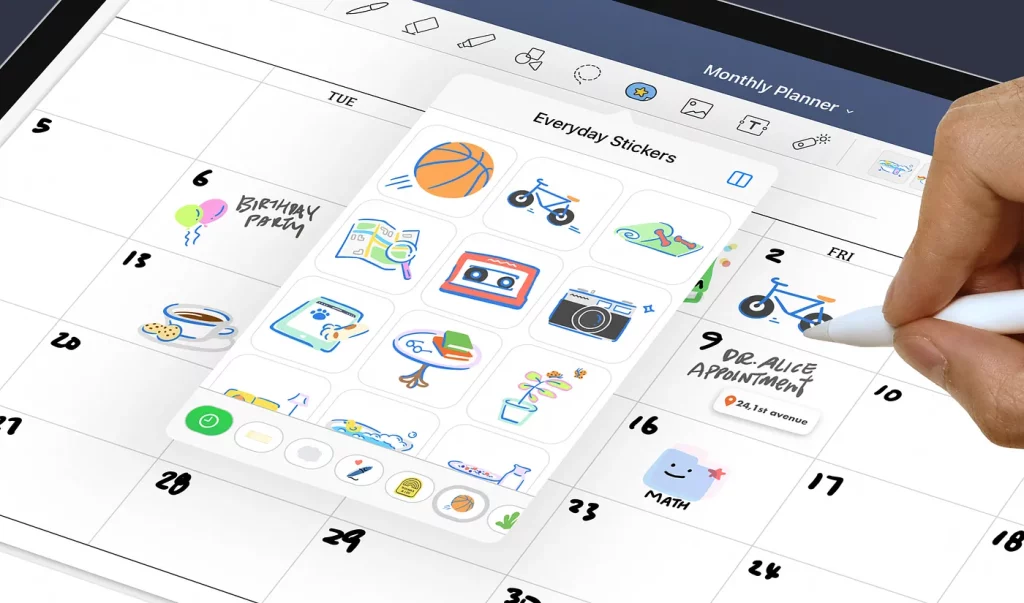
Goodnotes vs. Notability: Collaboration
These days, note-taking isn’t just a solo pursuit. Digital note-taking is a staple in school rooms, college classes, and professional environments across the globe. More and more notetakers are on the lookout for collaborative apps that they can use with friends and colleagues.
Goodnotes – Collaboration
Goodnotes offers all the collaboration features we would expect to see on a popular note-taking app. It supports real-time collaboration, which is considered the gold standard for avid notetakers.
The process is extremely simple. Just enable link sharing and send the link to your collaborator. Once they have opened the URL, the shared document will download to their library and you can work together on the same version.
Pros
- Real-time collaboration feature streamlines your work.
- Anyone with the link can collaborate, making feedback super easy.
Cons
- Some users report a significant lag during collaborative work.
Notability – Collaboration
Likewise, Notability has a Share Link feature. Simply go to Select, press Share Options, then select Share Link. Once you have the link, you can open the note, make changes and suggestions, and send it back to your colleague.
Unfortunately, Notability does not yet support real-time editing and collaboration. This is one of the biggest downsides of the app, and we have to wonder whether the devs are working toward a solution.
Pros
- Share your notes with others within a few seconds.
Cons
- No real-time collaboration tools, making it pale in comparison to Goodnotes and other more advanced note-taking apps.
Winner: Goodnotes
Goodnotes has rightfully won this round. At this point, notetakers expect the latest note-taking apps to have collaboration tools, which is why it is such a surprise that Notability has not yet perfected the art of real-time collaboration.
There is evidence that some Goodnotes users experience lag during collaborative work, but given the other option, we’ll take it!
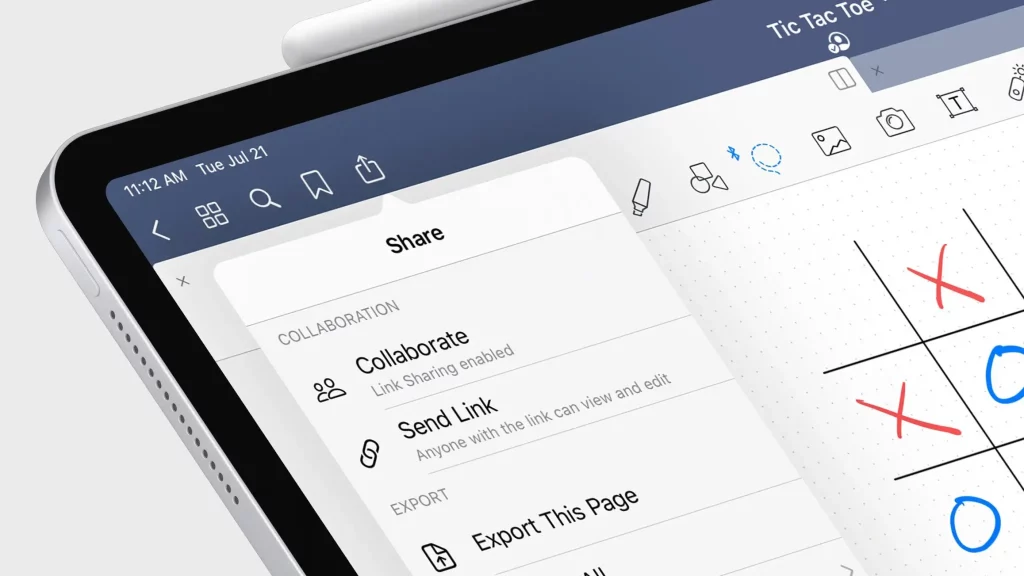
Reviews
Goodnotes has 4.8/5 stars on the Apple App Store, which is impressive considering the app has over 89,000 reviews. Goodnotes also won the Apple iPad App of the Year Award in 2022, proving it is worthy of industry accolades.
Notability has a slightly lower (but still impressive) overall score. It has 4.7/5 stars on the Apple App Store, and 39,000 reviews.
Winner: Goodnotes
We can see a trend emerging. In the battle of Goodnotes vs. Notability, Goodnotes is the favorite.
The reviews don’t lie, but it is worth mentioning that Notability has less than half the reviews that Goodnotes does and only a slightly lower overall score. Notetakers all over the globe love using Notability, so it’s not out of the running just yet!
Price
Goodnotes
- Limited plan: Free
- Full version for iOS: $9.99 annually, or a one-time purchase of $29.99
- Full version on Windows/Android: $6.99
Notability
- Limited plan: Free
- Plus plan: $2.99 monthly, or $14.99 annually
Winner: Goodnotes
Unfortunately for Notability fans, a significant portion of the most impressive features are only available on the Plus package. This setback wouldn’t be too serious if the Plus subscription wasn’t more expensive than Goodnotes.
Goodnotes offers an annual price plan that is only $9.99. In comparison, Notability Plus costs $2.99 per month or $14.99 a year.
Final Thoughts
Notability vs. Goodnotes is a popular debate, but we think we might have gotten to the bottom of it.
Ultimately, it all depends on personal preferences. If you want to streamline your notetaking sessions with the latest AI innovations, Goodnotes is the app for you. But if you want to use a more streamlined user interface, Notability will soon be your favorite notetaking app.
For us, Goodnotes is just too good to ignore. The AI writing aid is a big plus point, but we also love their other innovative features such as interactive SAT prep and the timed flashcards. It has earned its reputation as the best notetaking app, and, in keeping with the company’s bold claims, has proven itself to be “loved by millions around the world.”
Just to be clear, Notability is also a great choice and full of unique, effective features such as its math conversion functionality. Overall, Notability is a solid (albeit slightly too expensive) notetaking app. But, when compared to Goodnotes, it is our second-best option.
Rock Paper Pencil: A Pen-On-Paper Experience for iPad
If you’re using Goodnotes or Notability to take notes on your iPad, you might be interested in Rock Paper Pencil.
Taking notes on an iPad can feel strange, especially if you’re accustomed to using paper. On its own, the iPad’s glass screen is a slippery surface that can cause messy handwriting. Luckily, Rock Paper pencil creates a realistic pen-on-paper feel for iPad.
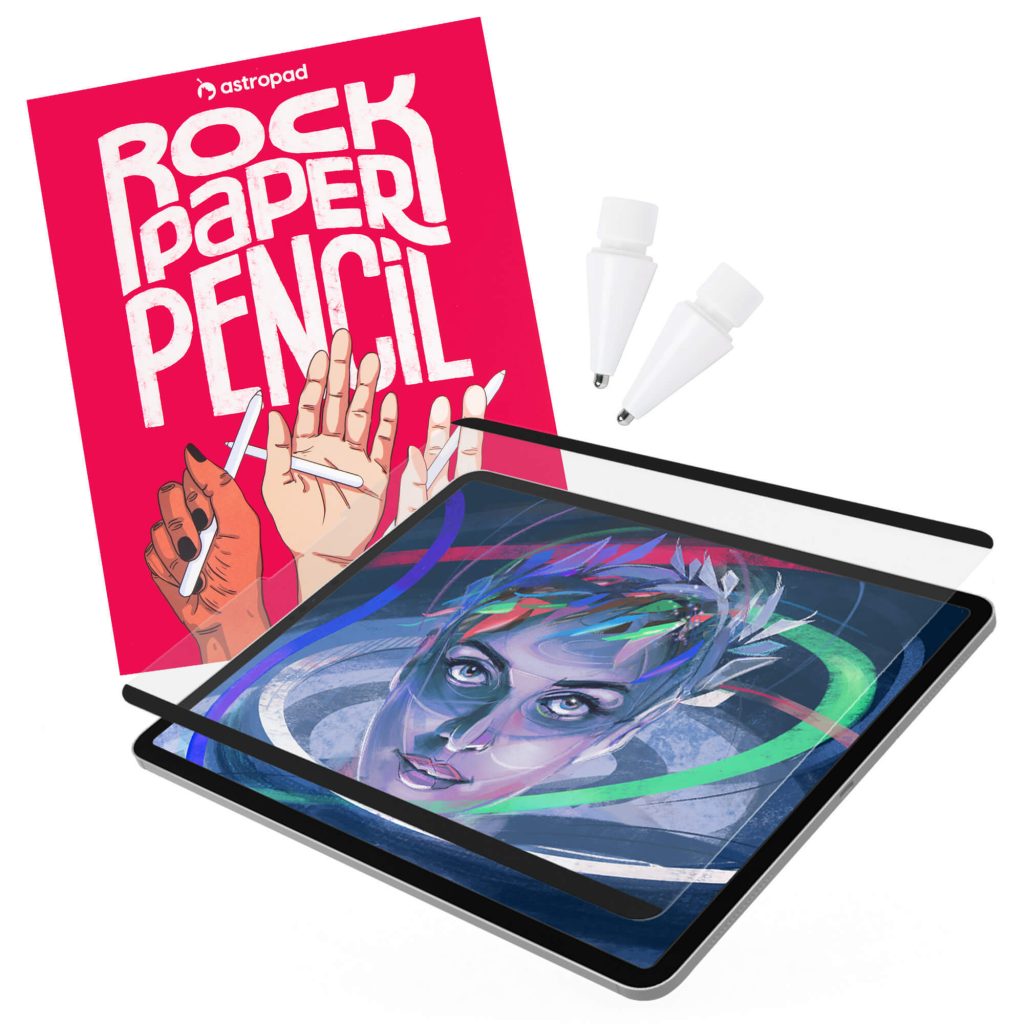
Rock Paper Pencil includes a reusable, paper-feel iPad screen protector and two ballpoint Apple Pencil tips. Built with nano-texture technology, Rock Paper Pencil adds subtle friction between your screen and Pencil, giving you more control while drawing or writing.
- NanoCling Screen Protector: Securely bond your screen protector to your iPad using static cling. Easy application, non-adhesive, removable and reusable.
- Matte Texture: Subtle friction mimics the feel of paper (no more slippery glass!)
- Precision Apple Pencil Tips: Smoother, more controlled strokes
Looking for an iPad stand to make notetaking more comfortable? Check out the 8 Best iPad Stands for Notetakers.



